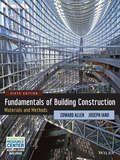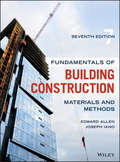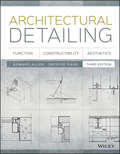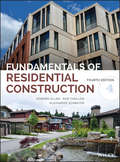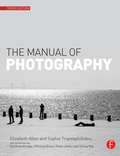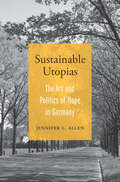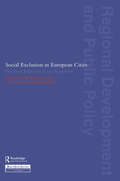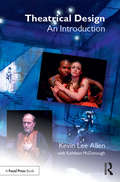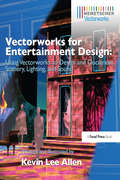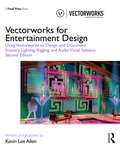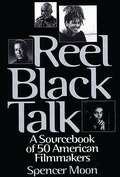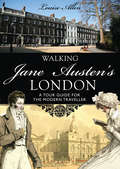- Table View
- List View
Fundamentals of Building Construction: Materials and Methods
by Edward Allen Joseph IanoNote from the publisher:Now in its sixth edition, this bestselling reference focuses on the basic materials and methods used in building construction. Emphasizing common construction systems such as light wood frame, masonry bearing wall, steel frame, and reinforced concrete construction, the new edition includes new information on building materials properties; the latest on "pre-engineered" building components and sustainability issues; and reflects the latest building codes and standards. It also features an expanded series of case studies along with more axonometric detail drawings and revised photographs for a thoroughly illustrated approach.
Fundamentals of Building Construction: Materials and Methods
by Edward Allen Joseph IanoTHE #1 REFERENCE ON BUILDING CONSTRUCTION—UPDATED FROM THE GROUND UP Edward Allen and Joseph Iano’s Fundamentals of Building Construction has been the go-to reference for thousands of professionals and students of architecture, engineering, and construction technology for over thirty years. The materials and methods described in this new Seventh Edition have been thoroughly updated to reflect the latest advancements in the industry. Carefully selected and logically arranged topics—ranging from basic building methods to the principles of structure and enclosure—help readers gain a working knowledge of the field in an enjoyable, easy-to-understand manner. All major construction systems, including light wood frame, mass timber, masonry, steel frame, light gauge steel, and reinforced concrete construction, are addressed. Now in its Seventh Edition, Fundamentals of Building Construction contains substantial revisions and updates. New illustrations and photographs reflect the latest practices and developments in the industry. Revised chapters address exterior wall systems and high-performance buildings, an updated and comprehensive discussion of building enclosure science, evolving tools for assessing environmental and health impacts of building materials, and more. New and exciting developments in mass timber construction are also included. This Seventh Edition includes: 125 new or updated illustrations and photographs, as well as 40 new photorealistic renderings The latest in construction project delivery methods, construction scheduling, and trends in information technology affecting building design and construction Updated discussion of the latest LEED and Living Building Challenge sustainability standards along with expanded coverage of new methods for assessing the environmental impacts of materials and buildings Expanded coverage of mass timber materials, fire resistance of mass timber, and the design and construction of tall wood buildings Revised end-of-chapter sections, including references, websites, key terminology, review questions, and exercises Fully-updated collection of best-in-class ancillary materials: PowerPoint lecture slides, Instructor’s Manual, Test Bank, Interactive Exercises, and more Companion book, Exercises in Building Construction, available in print and eBook format For the nuts and bolts on building construction practices and materials, Fundamentals of Building Construction: Materials and Methods, 7th Edition lays the foundation that every architect and construction professional needs to build a successful career.
Fundamentals of Building Construction: Materials and Methods
by Edward Allen Joseph IanoTHE #1 REFERENCE ON BUILDING CONSTRUCTION—UPDATED FROM THE GROUND UP Edward Allen and Joseph Iano’s Fundamentals of Building Construction has been the go-to reference for thousands of professionals and students of architecture, engineering, and construction technology for over thirty years. The materials and methods described in this new Seventh Edition have been thoroughly updated to reflect the latest advancements in the industry. Carefully selected and logically arranged topics—ranging from basic building methods to the principles of structure and enclosure—help readers gain a working knowledge of the field in an enjoyable, easy-to-understand manner. All major construction systems, including light wood frame, mass timber, masonry, steel frame, light gauge steel, and reinforced concrete construction, are addressed. Now in its Seventh Edition, Fundamentals of Building Construction contains substantial revisions and updates. New illustrations and photographs reflect the latest practices and developments in the industry. Revised chapters address exterior wall systems and high-performance buildings, an updated and comprehensive discussion of building enclosure science, evolving tools for assessing environmental and health impacts of building materials, and more. New and exciting developments in mass timber construction are also included. This Seventh Edition includes: 125 new or updated illustrations and photographs, as well as 40 new photorealistic renderings The latest in construction project delivery methods, construction scheduling, and trends in information technology affecting building design and construction Updated discussion of the latest LEED and Living Building Challenge sustainability standards along with expanded coverage of new methods for assessing the environmental impacts of materials and buildings Expanded coverage of mass timber materials, fire resistance of mass timber, and the design and construction of tall wood buildings Revised end-of-chapter sections, including references, websites, key terminology, review questions, and exercises Fully-updated collection of best-in-class ancillary materials: PowerPoint lecture slides, Instructor’s Manual, Test Bank, Interactive Exercises, and more Companion book, Exercises in Building Construction, available in print and eBook format For the nuts and bolts on building construction practices and materials, Fundamentals of Building Construction: Materials and Methods, 7th Edition lays the foundation that every architect and construction professional needs to build a successful career.
Architectural Detailing: Function, Constructibility, Aesthetics
by Edward Allen Patrick RandThe industry-standard guide to designing well-performing buildings Architectural Detailing systematically describes the principles by which good architectural details are designed. Principles are explained in brief, and backed by extensive illustrations that show you how to design details that will not leak water or air, will control the flow of heat and water vapor, will adjust to all kinds of movement, and will be easy to construct. This new third edition has been updated to conform to International Building Code 2012, and incorporates current knowledge about new material and construction technology. Sustainable design issues are integrated where relevant, and the discussion includes reviews of recent built works that extract underlying principles that can be the basis for new patterns or the alteration and addition to existing patterns. Regulatory topics are primarily focused on the US, but touch on other jurisdictions and geographic settings to give you a well-rounded perspective of the art and science of architectural detailing. In guiding a design from idea to reality, architects design a set of details that show how a structure will be put together. Good details are correct, complete, and provide accurate information to a wide variety of users. By demonstrating the use of detail patterns, this book teaches you how to design a building that will perform as well as you intend. Integrate appropriate detailing into your designs Learn the latest in materials, assemblies, and construction methods Incorporate sustainable design principles and current building codes Design buildings that perform well, age gracefully, and look great Architects understand that aesthetics are only a small fraction of good design, and that stability and functionality require a deep understanding of how things come together. Architectural Detailing helps you bring it all together with a well fleshed-out design that communicates accurately at all levels of the construction process.
Architectural Detailing: Function, Constructibility, Aesthetics
by Edward Allen Patrick RandThe industry-standard guide to designing well-performing buildings Architectural Detailing systematically describes the principles by which good architectural details are designed. Principles are explained in brief, and backed by extensive illustrations that show you how to design details that will not leak water or air, will control the flow of heat and water vapor, will adjust to all kinds of movement, and will be easy to construct. This new third edition has been updated to conform to International Building Code 2012, and incorporates current knowledge about new material and construction technology. Sustainable design issues are integrated where relevant, and the discussion includes reviews of recent built works that extract underlying principles that can be the basis for new patterns or the alteration and addition to existing patterns. Regulatory topics are primarily focused on the US, but touch on other jurisdictions and geographic settings to give you a well-rounded perspective of the art and science of architectural detailing. In guiding a design from idea to reality, architects design a set of details that show how a structure will be put together. Good details are correct, complete, and provide accurate information to a wide variety of users. By demonstrating the use of detail patterns, this book teaches you how to design a building that will perform as well as you intend. Integrate appropriate detailing into your designs Learn the latest in materials, assemblies, and construction methods Incorporate sustainable design principles and current building codes Design buildings that perform well, age gracefully, and look great Architects understand that aesthetics are only a small fraction of good design, and that stability and functionality require a deep understanding of how things come together. Architectural Detailing helps you bring it all together with a well fleshed-out design that communicates accurately at all levels of the construction process.
Fundamentals of Residential Construction
by Edward Allen Rob Thallon Alexander C. SchreyerThe leading guide to professional home construction, updated and expanded Fundamentals of Residential Construction is the definitive guide to single family and multifamily home building that details every step of the construction process. From siting and foundations to finishing details, this book provides a complete walk-through of professional home construction. Over 1,200 drawings and photographs animate the textbook, while interactive supplementary online resources help facilitate an understanding of the material. This fourth edition accommodates the latest developments in materials and methods, including new coverage of sustainable building and energy efficiency, multifamily construction, prefabricated building components, and CAD/BIM planning tools in residential construction. Authoritative coverage of wood light-frame construction, building systems, industrialized fabrication, insulating concrete forms, light-gauge steel and masonry construction, multi-family buildings, and more provides a solid foundation in residential construction methods, tools, and processes. Building a home requires a deeply integrated understanding of materials, structures, codes, and management procedures. Because the process involves such a broad array of considerations and challenges, construction professionals must regularly draw on a clear body of knowledge to keep a project running smoothly. This book helps you lay the groundwork of expertise required to successfully complete a residential project. • Learn the advantages and disadvantages of common materials and systems • Understand site preparation, foundations, and framing • Delve into the details of roofing, finishing, and energy efficiency • Understand heating/cooling, plumbing, and electrical options • Examine the latest codes, costs, and management best practices Designing and constructing a home presents a unique project dynamic; people's homes are their sanctuaries, where they make the memories of a lifetime. They must be designed to be lived in, not simply "used." Lifetime costs play a major role in decision-making, materials must be carefully chosen and sourced, and spaces must be structured to be efficient yet enjoyable. Fundamentals of Residential Construction shows you how to bring it all together to turn a project into a family's cherished home.
Fundamentals of Residential Construction
by Edward Allen Rob Thallon Alexander C. SchreyerThe leading guide to professional home construction, updated and expanded Fundamentals of Residential Construction is the definitive guide to single family and multifamily home building that details every step of the construction process. From siting and foundations to finishing details, this book provides a complete walk-through of professional home construction. Over 1,200 drawings and photographs animate the textbook, while interactive supplementary online resources help facilitate an understanding of the material. This fourth edition accommodates the latest developments in materials and methods, including new coverage of sustainable building and energy efficiency, multifamily construction, prefabricated building components, and CAD/BIM planning tools in residential construction. Authoritative coverage of wood light-frame construction, building systems, industrialized fabrication, insulating concrete forms, light-gauge steel and masonry construction, multi-family buildings, and more provides a solid foundation in residential construction methods, tools, and processes. Building a home requires a deeply integrated understanding of materials, structures, codes, and management procedures. Because the process involves such a broad array of considerations and challenges, construction professionals must regularly draw on a clear body of knowledge to keep a project running smoothly. This book helps you lay the groundwork of expertise required to successfully complete a residential project. • Learn the advantages and disadvantages of common materials and systems • Understand site preparation, foundations, and framing • Delve into the details of roofing, finishing, and energy efficiency • Understand heating/cooling, plumbing, and electrical options • Examine the latest codes, costs, and management best practices Designing and constructing a home presents a unique project dynamic; people's homes are their sanctuaries, where they make the memories of a lifetime. They must be designed to be lived in, not simply "used." Lifetime costs play a major role in decision-making, materials must be carefully chosen and sourced, and spaces must be structured to be efficient yet enjoyable. Fundamentals of Residential Construction shows you how to bring it all together to turn a project into a family's cherished home.
Form and Forces: Designing Efficient, Expressive Structures (Coursesmart Ser.)
by Edward Allen Waclaw ZalewskiHere, in one volume, is all the architect needs to know to participate in the entire process of designing structures. Emphasizing bestselling author Edward Allen's graphical approach, the book enables you to quickly determine the desired form of a building or other structure and easily design it without the need for complex mathematics. This unique text teaches the whole process of structural design for architects, including selection of suitable materials, finding a suitable configuration, finding forces and size members, designing appropriate connections, and proposing a feasible method of erection. Chapters are centered on the design of a whole structure, from conception through construction planning.
Form and Forces: Designing Efficient, Expressive Structures
by Edward Allen Waclaw ZalewskiHere, in one volume, is all the architect needs to know to participate in the entire process of designing structures. Emphasizing bestselling author Edward Allen's graphical approach, the book enables you to quickly determine the desired form of a building or other structure and easily design it without the need for complex mathematics. This unique text teaches the whole process of structural design for architects, including selection of suitable materials, finding a suitable configuration, finding forces and size members, designing appropriate connections, and proposing a feasible method of erection. Chapters are centered on the design of a whole structure, from conception through construction planning.
The Manual of Photography and Digital Imaging
by Elizabeth Allen Sophie TriantaphillidouThe tenth edition of The Manual of Photography is an indispensable textbook for anyone who is serious about photography. It is ideal if you want to gain insight into the underlying scientific principles of photography and digital imaging, whether you are a professional photographer, lab technician, researcher or student in the field, or simply an enthusiastic amateur. This comprehensive guide takes you from capture to output in both digital and film media, with sections on lens use, darkroom techniques, digital cameras and scanners, image editing techniques and processes, workflow, digital file formats and image archiving. This iconic text was first published in 1890 and has aided many thousands of photographers in developing their own techniques and understanding of the medium. Now in full colour, The Manual of Photography still retains its clear, reader-friendly style and is filled with images and illustrations demonstrating the key principles. Not only giving you the skills and know-how to take stunning photographs, but will also allowing you to fully understand the science behind the creation of great images.
The Manual of Photography and Digital Imaging
by Elizabeth Allen Sophie TriantaphillidouThe tenth edition of The Manual of Photography is an indispensable textbook for anyone who is serious about photography. It is ideal if you want to gain insight into the underlying scientific principles of photography and digital imaging, whether you are a professional photographer, lab technician, researcher or student in the field, or simply an enthusiastic amateur. This comprehensive guide takes you from capture to output in both digital and film media, with sections on lens use, darkroom techniques, digital cameras and scanners, image editing techniques and processes, workflow, digital file formats and image archiving. This iconic text was first published in 1890 and has aided many thousands of photographers in developing their own techniques and understanding of the medium. Now in full colour, The Manual of Photography still retains its clear, reader-friendly style and is filled with images and illustrations demonstrating the key principles. Not only giving you the skills and know-how to take stunning photographs, but will also allowing you to fully understand the science behind the creation of great images.
Windows for the world: Nineteenth-century stained glass and the international exhibitions, 1851–1900 (Studies In Design Mup Ser.)
by Jasmine AllenThis study focuses on the significance of the displays of stained glass at several international exhibitions held in Britain, France, the USA and Australia between 1851 and 1900. It provides new perspectives for the study of nineteenth-century stained glass, within these temporary secular exhibition contexts.
Windows for the world: Nineteenth-century stained glass and the international exhibitions, 1851–1900 (Studies In Design And Material Culture Ser.)
by Jasmine AllenWindows for the world explores the display and reception of nineteenth-century British stained glass in a secular exhibition context. International in scope, the book focuses on the global development of stained glass in this period as showcased at, and influenced by, these exhibitions. It recognises those who made and exhibited stained glass and demonstrates the long-lasting impact of the classification and modes of display at these events. A number of exhibits are illustrated in colour and are analysed in relation to stylistic developments, techniques and material innovations, as well as the broader iconographies of nation and empire in the nineteenth century.
Sustainable Utopias: The Art and Politics of Hope in Germany
by Jennifer L. AllenTo reclaim a sense of hope for the future, German activists in the late twentieth century engaged ordinary citizens in innovative projects that resisted alienation and disenfranchisement. By most accounts, the twentieth century was not kind to utopian thought. The violence of two world wars, Cold War anxieties, and a widespread sense of crisis after the 1973 global oil shock appeared to doom dreams of a better world. The eventual victory of capitalism and, seemingly, liberal democracy relieved some fears but exchanged them for complacency and cynicism. Not, however, in West Germany. Jennifer Allen showcases grassroots activism of the 1980s and 1990s that envisioned a radically different society based on community-centered politics—a society in which the democratization of culture and power ameliorated alienation and resisted the impotence of end-of-history narratives. Berlin’s History Workshop liberated research from university confines by providing opportunities for ordinary people to write and debate the story of the nation. The Green Party made the politics of direct democracy central to its program. Artists changed the way people viewed and acted in public spaces by installing objects in unexpected environments, including the Stolpersteine: paving stones, embedded in residential sidewalks, bearing the names of Nazi victims. These activists went beyond just trafficking in ideas. They forged new infrastructures, spaces, and behaviors that gave everyday people real agency in their communities. Undergirding this activism was the environmentalist concept of sustainability, which demanded that any alternative to existing society be both enduring and adaptable. A rigorous but inspiring tale of hope in action, Sustainable Utopias makes the case that it is still worth believing in human creativity and the labor of citizenship.
Healthy Buildings: How Indoor Spaces Drive Performance and Productivity
by Joseph G. Allen John D. Macomber“This book should be essential reading for all who commission, design, manage, and use buildings—indeed anyone who is interested in a healthy environment.” —Norman Foster A forensic investigator of “sick buildings” and Director of Harvard’s Healthy Buildings Program teams up with a CEO-turned–Harvard Business School professor to reveal the secrets of a healthy building—and unlock one of the greatest business opportunities of our time. By the time you reach eighty, you will have spent seventy-two years of your life indoors. Like it or not, humans have become an indoor species. This means that the people who design, build, and maintain our buildings can have a major impact on our health. Ever feel tired during a meeting? That’s because most offices and conference rooms are not bringing in enough fresh air. When that door opens, it literally breathes life back into the room. But there is a lot more acting on your body that you can’t feel or see. From our offices and homes to our schools and hospitals, the indoor spaces where we work, learn, play, eat, and heal have an outsized influence on our performance and wellbeing. They affect our creativity, focus, and problem-solving ability and can make us sick—dragging down profits in the process. Charismatic pioneers of the healthy building movement who have paired up to combine the cutting-edge science of Harvard’s School of Public Health with the financial know-how of the Harvard Business School, Joseph Allen and John Macomber lay out the science of healthy buildings and make the business case for owners, developers, and CEOs. They reveal the 9 Foundations of a Healthy Building, and show how tracking health performance indicators with smart technology can boost performance and create economic value. While the “green” building movement tackled energy, waste, and water, the new healthy building movement focuses on the most important (and expensive) asset of any business: its people.
Social Exclusion in European Cities: Processes, Experiences and Responses (Regions and Cities)
by Judith Allen Goran Cars Ali MadanipourAcross Europe concern is rising over the disintegration of social relations and the growing number of people who are being socially excluded. social Exclustoin in European Cities, the first major study of this topic, provides a definition of social exclusion and looks at both the processes which cause it and the dimensions of the problem throughout Europe. The experiences of people living in areas or neighbourhoods with low rates of social integration are considered, illuminating the human impact of exclusion where it is most visible. Finally the contributors evaluate the various policy and community initiatives which are currently confronting the problem in a wide sample of European Cities on a variety of levels, from inform individual actions to supra-national European Union policy, and suggest new ways in which social exclusion could be tackled. With most large cities experiencing some degree of social exclusion, this is an important volume for all those working in the areas of regional policy, town planning, housing management, social work, community development, sociology, political science and urban studies.
Theatrical Design: An Introduction
by Kevin Lee AllenA theatrical designer must address two questions when designing a production: What is the play about and what is the play like? To find the metaphor within a play is to unlock inspired and unique design concepts. Theatrical Design: An Introduction is about how to find the design idea for a production and what to do with that idea once identified. This book emphasizes script analysis and interpretation specifically for designers: how to release meaning and design inspiration from lines and characterization in a script. It then explains the artistic elements and principles of design—the skills necessary to create the design visualized. Concepts are illustrated with examples from theatre, film, art, architecture, and fashion that explore professional and historic use of conceptualization and metaphor. Theatrical Design: An Introduction imparts the tools designers need to innovate off the page.
Theatrical Design: An Introduction
by Kevin Lee AllenA theatrical designer must address two questions when designing a production: What is the play about and what is the play like? To find the metaphor within a play is to unlock inspired and unique design concepts. Theatrical Design: An Introduction is about how to find the design idea for a production and what to do with that idea once identified. This book emphasizes script analysis and interpretation specifically for designers: how to release meaning and design inspiration from lines and characterization in a script. It then explains the artistic elements and principles of design—the skills necessary to create the design visualized. Concepts are illustrated with examples from theatre, film, art, architecture, and fashion that explore professional and historic use of conceptualization and metaphor. Theatrical Design: An Introduction imparts the tools designers need to innovate off the page.
Vectorworks for Entertainment Design: Using Vectorworks to Design and Document Scenery, Lighting, and Sound
by Kevin Lee AllenThe first book in the industry tailored specifically for the entertainment professional, Vectorworks for Entertainment Design covers the ins and outs of Vectorworks software for lighting, scenic, and sound design. With a detailed look at the design process, from idea to development, to the documentation necessary for execution, Vectorworks for Entertainment Design will encourage you to create your own process and workflow through exercises that build on one another. The text stresses the process of developing an idea, visualizing it, and evolving it for presentation, documentation, or drafting. The author focuses on both the technical how-to and the art of design, giving you the tools you need to learn and then use the application professionally. Fully illustrated with step-by-step instructions, it contains inspirational work from Broadway, major regional companies, and non-theatrical, entertainment design.
Vectorworks for Entertainment Design: Using Vectorworks to Design and Document Scenery, Lighting, and Sound
by Kevin Lee AllenThe first book in the industry tailored specifically for the entertainment professional, Vectorworks for Entertainment Design covers the ins and outs of Vectorworks software for lighting, scenic, and sound design. With a detailed look at the design process, from idea to development, to the documentation necessary for execution, Vectorworks for Entertainment Design will encourage you to create your own process and workflow through exercises that build on one another. The text stresses the process of developing an idea, visualizing it, and evolving it for presentation, documentation, or drafting. The author focuses on both the technical how-to and the art of design, giving you the tools you need to learn and then use the application professionally. Fully illustrated with step-by-step instructions, it contains inspirational work from Broadway, major regional companies, and non-theatrical, entertainment design.
Vectorworks for Entertainment Design: Using Vectorworks to Design and Document Scenery, Lighting, Rigging and Audio Visual Systems
by Kevin Lee AllenVectorworks for Entertainment Design is the first book in the industry tailored for the entertainment professional. This second edition has been extensively revised and updated, covering the most current details of the Vectorworks software for scenery, lighting, sound, and rigging. With a focused look at the production process from ideation to development to documentation required for proper execution, the book encourages readers to better create their own processes and workflows through exercises that build on one another. This new edition introduces Braceworks, SubDivision modeling, and scripting using the Marionette tool, and covers new tools such as Video Camera, Deform Tool, Camera Match, Schematic Views, and Object Styles. Fully illustrated with step-by-step instructions, this volume contains inspirational and aspirational work from Broadway, Concerts, Regional Theatre, Dance, and Experiential Entertainment. Exploring both the technical how-to and the art of design, this book provides Theatre and Lighting Designers with the tools to learn about the application and use it professionally. Vectorworks for Entertainment Design also includes access to downloadable resources such as exercise files and images to accompany projects discussed within the book.
Vectorworks for Entertainment Design: Using Vectorworks to Design and Document Scenery, Lighting, Rigging and Audio Visual Systems
by Kevin Lee AllenVectorworks for Entertainment Design is the first book in the industry tailored for the entertainment professional. This second edition has been extensively revised and updated, covering the most current details of the Vectorworks software for scenery, lighting, sound, and rigging. With a focused look at the production process from ideation to development to documentation required for proper execution, the book encourages readers to better create their own processes and workflows through exercises that build on one another. This new edition introduces Braceworks, SubDivision modeling, and scripting using the Marionette tool, and covers new tools such as Video Camera, Deform Tool, Camera Match, Schematic Views, and Object Styles. Fully illustrated with step-by-step instructions, this volume contains inspirational and aspirational work from Broadway, Concerts, Regional Theatre, Dance, and Experiential Entertainment. Exploring both the technical how-to and the art of design, this book provides Theatre and Lighting Designers with the tools to learn about the application and use it professionally. Vectorworks for Entertainment Design also includes access to downloadable resources such as exercise files and images to accompany projects discussed within the book.
Reel Black Talk: A Sourcebook of 50 American Filmmakers (Non-ser.)
by Linda Allen Spencer MoonAs evidenced in interviews included in this volume, many African American filmmakers consider themselves artists first, their ethnicity being only part of what influences their work. This is the first book by an African American on contemporary African American filmmakers. Here directors and producers speak for themselves, posing challenges to current thinking in the field. Special emphasis is given to the filmmakers' productions and their experiences. Essays on historic figures reveal the rich history of the African American contribution to cinema. From Oscar Micheaux and Spencer Williams to Neema Barnett and the team of George Jackson and Doug McHenry, this revealing reference work will enlighten scholars, students, and film buffs.As early as 1899, African Americans were involved in the filmmaking industry. Oscar Micheaux took directing, writing, and producing to a higher level with the release of his first film in 1918; by 1948 he had made more than forty films. Currently, by international world cinema standards, the African American tradition rivals cinema from anywhere in the world, but these filmmakers face a quandary: whether to make films through the Hollywood system or follow an independent vision. This book presents a cross-section of filmmakers from each camp and also focuses on those who work in both arenas.
St Edmund's Church and the Montagu Monuments
by Louise AllenSt Edmund's Church in the beautiful village of Warkton, Northamptonshire is an unassuming place – but it holds some of the most exquisite sculptures in all of Britain. Commissioned by the local Montagu family, these four Baroque marble statues commemorate the lives of four of their members. Two of the statues were created by Louis Francois Roubiliac, one of the greatest sculptors of Georgian England.Adorned with related poems by schoolchildren and other locals, this illustrated guide explains the history of St Edmund's Church, the Montagu family and the monuments they erected between the 1750s and 1830s. It also details their painstaking restoration in recent years and the role of the church in the community.
Walking Jane Austen’s London (Shire General Ser. #5)
by Louise AllenFrom prize-winning historical novelist Louise Allen, this book presents nine walks through both the London Jane Austen knew and the London of her novels! Follow in Jane's footsteps to her publisher's doorstep and the Prince Regent's vanished palace, see where she stayed when she was correcting proofs of Sense and Sensibility and accompany her on a shopping expedition – and afterwards to the theatre. In modern London the walker can still visit the church where Lydia Bennett married Wickham, stroll with Elinor Dashwood in Kensington Palace Gardens or imagine they follow Jane's naval officer brothers as they stride down Whitehall to the Admiralty. From well-known landmarks to hidden corners, these walks reveal a lost London that can still come alive in vivid detail for the curious visitor, who will discover eighteenth-century chop houses, elegant squares, sinister prisons, bustling city streets and exclusive gentlemen's clubs amongst innumerable other Austen-esque delights.
